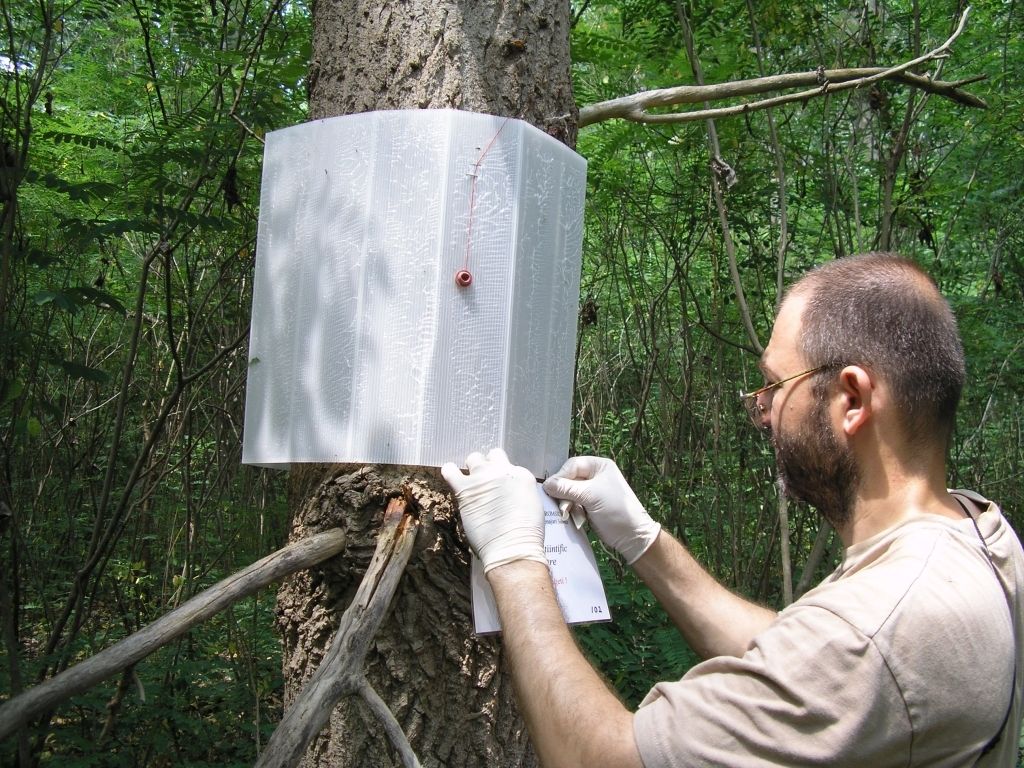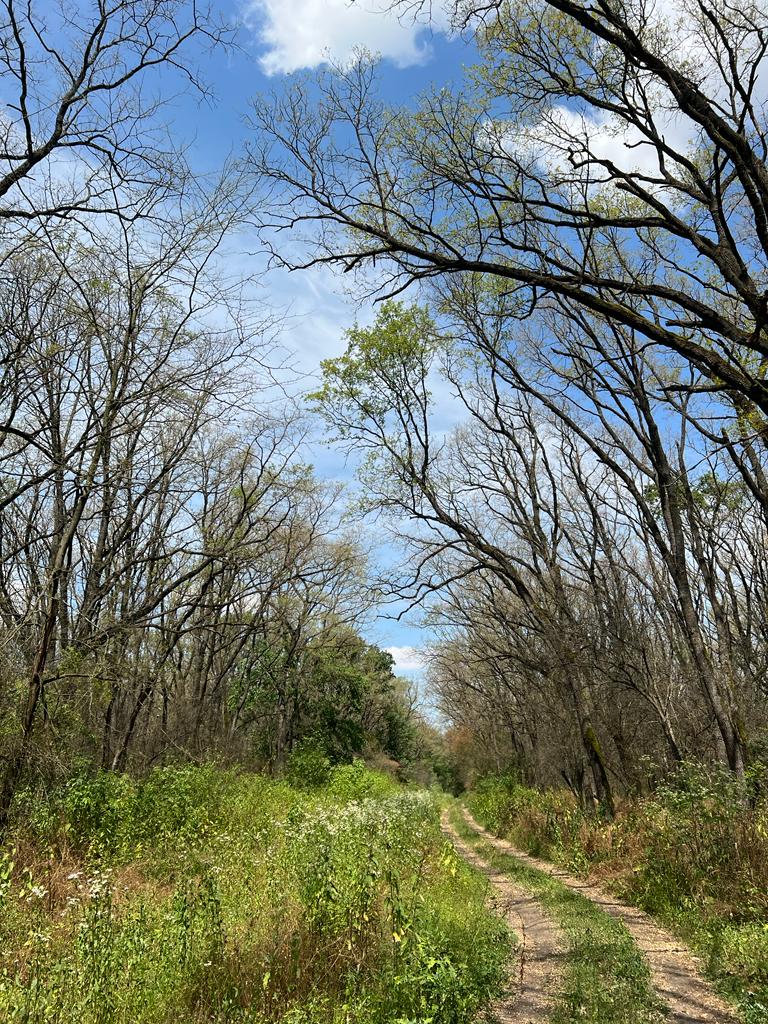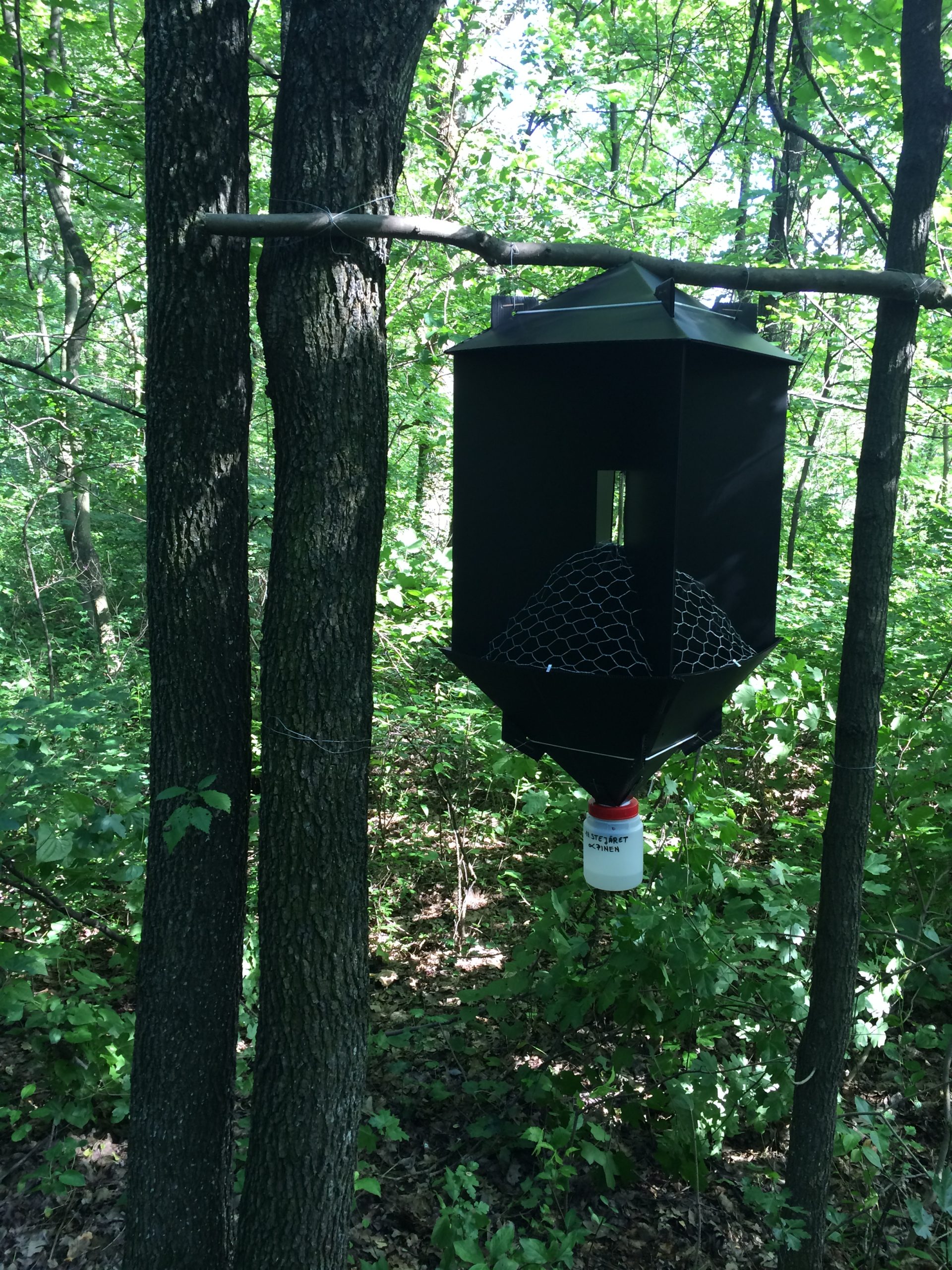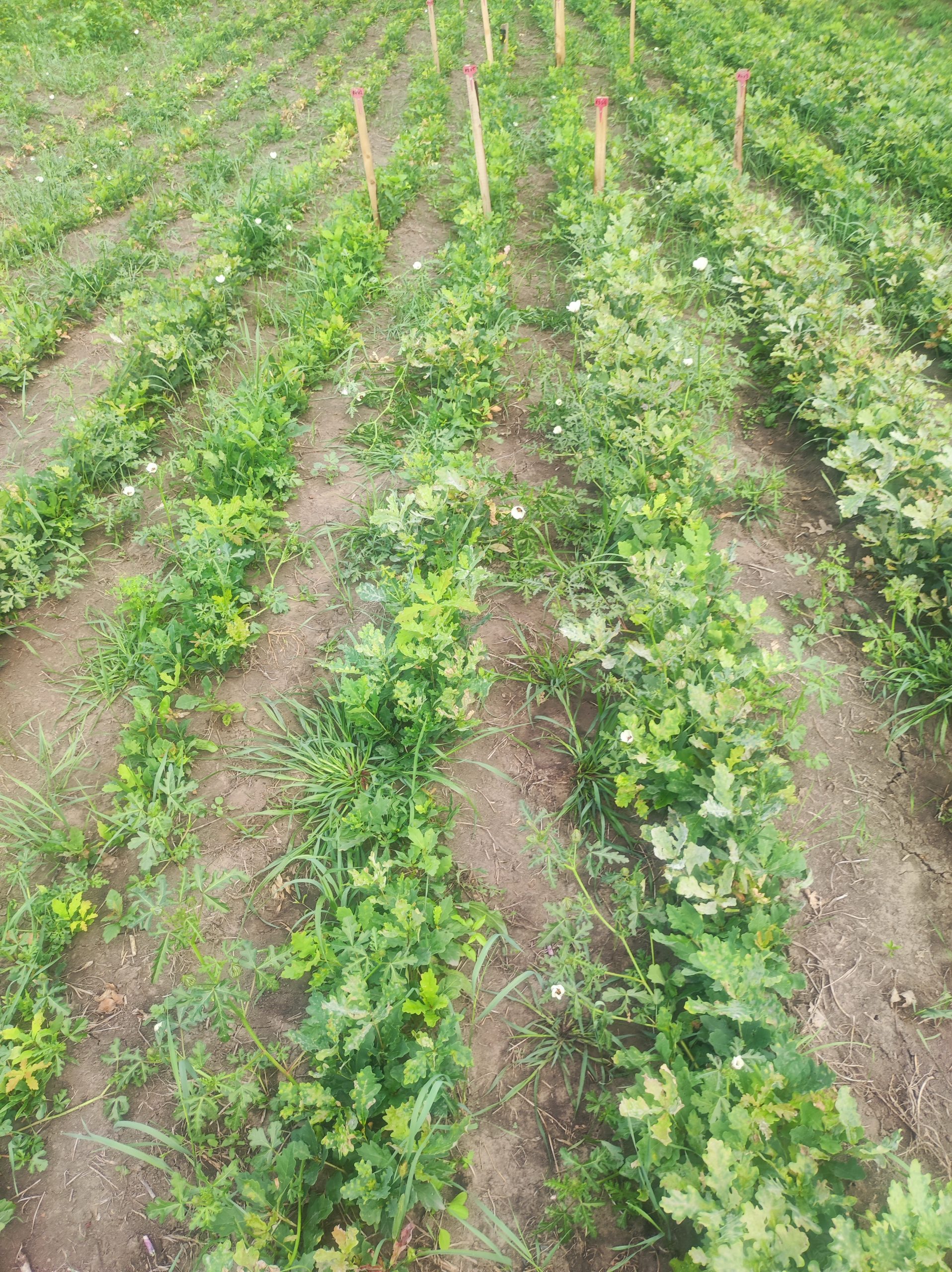
The research team carries out specific activities in order to maintain the health of the forests by developing the methods of surveillance and control of harmful forest agents (biotic and abiotic).
Organization

Chira Dănuț
Senior researchers I, head of Brașov Research Section
Research Team Manager (E6)
Areas of interest: forest protection, forest ecology
Activity
The main objective of the research team is to know the biotic (harmful invertebrates and vertebrates, pathogenic cryptogamic agents) and abiotic factors that weaken forest species, respectively the methods, means, techniques and technologies of their surveillance, detection, forecasting, prevention and combat.
Objectives – Research directions
- continuous improvement of the detection/identification and monitoring procedures of invertebrate animals (insects, mites, gastropods, etc.) and vertebrates (birds, mammals and other organisms), of cryptogamic agents (viruses, phytoplasmas, bacteria, oomycetes, fungi) and parasitic plants harmful to forest species;
- development of forecasting methods of the main defoliating insects;
- highlighting the limiting cryptogamic agents of the populations of insects and fungi harmful to forest crops and the development of biological preparations (viral, bacterial or mycotic) necessary for the biological control of the main pests and pathogens of woody species;
- the testing of biological products (pesticides or repellents) or with as little impact on the environment as possible, accepted by forest certification systems;
- the testing and gradual improvement of modern methods and technologies to prevent and combat the main diseases and pests with an impact on the health of forest stands and crops;
- selection of genotypes resistant to diseases and dangerous pests;
- assessment of the risk of emergence, colonization and spread of non-native (invasive) invertebrates and cryptogamic agents in forest ecosystems (and crops);
- estimating the impact of climate change on the dynamics of biotic and abiotic agents harmful to woody species;
- determining the biodiversity of invertebrates and fungi (mycorrhizal, saprophytic, parasitic) in forest ecosystems;
- understanding the role of different factors (abiotic and biotic) that compete in complex forest diseases that affect forest crops or stands of deciduous and coniferous trees;
- development of methods of culture of saprophytic fungi, production of mycorrhizal seedlings and extraction of substances of medicinal or food interest from mushrooms, forest insects.



Within the E6 research team, 10 researchers with proven experience (Senior researchers I and II), 11 researchers and 10 employees work as technical staff.
Research infrastructure and services
Research infrastructure
- Long-term experimental plantations on the resistance of national species / genotypes to diseases and pests;
- Long-term experimental blocks regarding the evolution of stands / forest crops affected by diseases and dangerous invertebrates;
- Short-, medium- and long-term experimental cultures regarding methods of detecting, preventing and combating harmful forest pathogens and invertebrates;
- Equipment for entomology, phytopathology and forest mycology laboratories:
- Air-conditioned growth, conditioning and storage rooms (for insects, pathogens, etc.) (air-conditioned rooms, incubators, refrigerators, cold boxes, etc.);
- Sterilization equipment (autoclaves, sterilizers, ovens, UV lamps, etc.);
- Equipment for the transplant of cryptogamic agents and in vitro cultures (sterile lamellar flow hoods);
- Equipment for detecting internal wood defects (Arbotom tomograph, resistograph, scanner);
- Equipment for molecular analysis (DNA extractor, Real Time PCR);
- Small Greenhouse;
- Detection, monitoring and recording equipment and tools (UAV / drones, GPS, weather stations, climate sensors, dataloggers, video cameras, etc.);
- Data analysis and processing equipment (high-magnitude microscopes and binoculars, analytical/electronic balances, photo/video cameras, computers, graphics stations, software, etc.).
Research services
- Providing technical assistance for the application of measures to detect/identify, monitor, forecast, prevent and combat diseases and pests of forest species;
- Providing technical assistance for the selection of prevention and control products (pesticides) approved by certification bodies;
- Carrying out risk studies regarding the occurrence, evolution and probable impact of diseases and pests on stands and forest crops;
- Making analysis bulletins on the identification of diseases and pests of saplings and trees (including recommendations on the management of affected stands / crops).
- Testing of products (pesticides) and methods for detecting, monitoring, preventing and combating pathogens and pests of forest (and ornamental) species;
- Experimental testing of biological control of biotic agents dangerous to woody species (forestry and ornamental);
- Carrying out studies to assess the biodiversity of insect and mushroom species in different forest ecosystems;
- Analysis of the phytosanitary status of potentially dangerous trees in parks and green areas (stem scan / tomography, tree stability, state of crowns, stems, roots);
- Providing technical assistance regarding the management of trees and shrubs (including conservation of monumental trees) affected by diseases and pests in urban forests, parks, green spaces;
- Providing technical assistance regarding the installation (and management) of truffalo crops;
- Carrying out evaluation studies on the state of biological resources of edible mushrooms, from the wild (spontaneous) flora of the forest stock;
- Carrying out appropriate assessment studies on the impact of investments (on protected insect and mushroom species) in protected areas;
- Carrying out pediatric studies;
- Carrying out ecological reconstruction studies of stands, especially those affected by diseases (cryptogamic, abiotic or complex) and dangerous (invasive or autochthonous) pests.
Relevant projects
- Simplified procedures for Forest Protection. SIPOCA 395 “The implementation and development of common systems and standards for the optimization of decision-making processes in the field of water and forests, the application of the system of evidence-based policies in the Ministry of Water and Forests for the systematization and simplification of legislation in the field of water and the implementation of simplified procedures to reduce the administrative burden
- Scientific foundations for the development of forest protection methods (FORCLIMSOC, C12N, PN23090102, 2023-2026).
- Monitoring of insect populations, the role of harmful biotic factors and management measures of quivercine stands (POC/Cresforlife CS7, 2019-2023)
- Integrated pest control measures for deciduous species (POC/Cresforlife CS8, 2019-2023)
- Preventing and combating diseases in nurseries and forestry crops (POC/Cresforlife CS9, 2019-2023)
- Integrated pest control measures for softwood species (POC/Cresforlife CS10, 2019-2022)
- Implementation and application of phytosanitary treatments with products accepted by the European Union and evaluation of the effectiveness of these (POC/Cresforlife CS11, 2019-2023)
- Monitoring the drying phenomenon of coniferous and deciduous stands (POC/Cresforlife CS12, 2019-2023)
- Conservative management for 4070 and 9260 habitats of ROSCI0129 North of Western Gorj (LIFE+11 NAT/RO/825, 2012-2019)
- Improving the methods of monitoring and combating harmful insects by using modern technologies (BIOSERV, PN19070202, 2019-2022)
- Identification and testing of new procedures for detecting the presence and monitoring of the main xylophagous pests (including invasive species) in softwoods (RNP-Romsilva, 2012-2015)
- Biological treatment of the Asian fungus Cryphonectria parasitica (POIM, 2021)
- Assessment of the risk of the appearance of new species of harmful insects with the potential for mass reproduction in deciduous forests in Romania (BIOSERV, PN19070201, 2019-2022)
- Xylosandrus germanus – invasive species in forest ecosystems in Romania (BIOSERV, PN19070203, 2019-2022)
- Identification and surveillance of damage caused by Acrobasis repandana in the sky groves in the south-east of the country (RNP-Romsilva, 2018-2019)
Recent publications
Books
- Simionescu A., Chira D., Mihalciuc V., Ciornei C., Tulbure C. (eds.), Vlădescu D., Tomescu R., Neţoiu C., Aldea I.D., Lupăşnean D., Chira F., Fulicea T., Manea A.I., Dinu M., Mantale C., Vulcan G., Vasile D., Liţescu M., Cucoş V., Rotariu C., Blaga T., Bercea I., Daia M., Ţilea G., Guţu F., Vlăduleasa A. (2012). Starea de sănătate a pădurilor din România în perioada 2001-2010. Ed. Muşatinii Group, 600 p., ISBN 978-606-656-017-7.
- Simionescu A., Mihalache G. (eds), Mihalciuc V., Ciornei C., Olenici N., Chira D., Lupu D., Neţoiu C., Vlăduleasa A., Iliescu M., Vişoiu D., Chira F., Rang C., Tăut I., Mihai D. (2000, 2003). Forest protection. Ed. Muşatinii, 880 p. ISBN 973-99309-7-2.
- Chira D., Bolea V., Chira F., Mantale C. (2018). Ghidul de management al habitatului 9260 „Vegetație forestieră cu Castanea sativa”. Ed. Teocora, 32 p. ISBN 978-606-632-506-6.
Chapters from books
- Tomescu R., Nețoiu C., Tăut I., Olenici N., Chira D. (2019). Forest protection. În Hera C. (coord.) Istoria științelor agricole și silvice în România. P.II. Istoria științelor horticole, silvice, zootehnice, medicină veterinară, economie agrară, dezvoltare rurală, știința alimentară. Civilizația românească 26/27. Ed. Academiei Române, pp. 798-804. ISBN978-973-27-3132-1.
ISI articles
- Paraschiv M. (2023). First record of the invasive scale insect, Pulvinaria hydrangeae Steinweden, 1946 (Hemiptera: Coccomorpha: Coccidae) in Romania. Insects, 14(4), 345.
- Arion I.D., Arion F.H., Tăut I., Mureșan I.C., Ilea M., & Dîrja M. (2023). Investment in forest watershed — A model of good practice for sustainable development of ecosystems. Water, 15(4), 754.
- Chira D., Borlea F.G., Chira F., Mantale C.Ș., Ciocîrlan M.I., Turcu D.O., Cadar N., Trotta V., Camele I., Marcone C., & Mang Ș.M. (2022). Selection of elms tolerant to Dutch elm disease in South-West Romania. Diversity, 14(11), 980.
- Olenici N., Bălăcenoiu F., Tomescu R., Nețoiu C., Buzatu A., Alexandru A. (2022). Invasive alien forest insect species in south-eastern Romania. Notulae Botanicae Horti Agrobotanici Cluj-Napoca 50(1), article number 12618. DOI: 10.15835/nbha201 12618
- Stăncioiu P.T., Dutcă I., Florea S.C., Paraschiv M. (2022). Measuring distances and areas under forest canopy conditions — A comparison of handheld mobile laser scanner and handheld global navigation satellite system. Forests, 13(11), 1893.
- Moldovan M., Tăut I., Rebrean F.A., Szilard B., Arion I.D., & Dîrja M. (2022). Determining the anti-erosion efficiency of forest stands installed on degraded land. Sustainability, 14(23), 15727.
- Ciocîrlan M.I.C., Curtu A.L., & Radu G.R. (2022). Predicting leaf phenology in forest tree species using UAVs and satellite images: A case study for European beech (Fagus sylvatica L.). Remote Sensing, 14(24), 6198.
- Olenici N., Fodor E. (2021). The diversity of saproxylic beetles’ community from the Natural Reserve Voievodeasa Forest, North-Eastern Romania. Ann. For. Res. 64(1): 31-60.
- Klimetzek D., Stancioiu P.T., Paraschiv M., Nita M.D. (2021). Ecological monitoring with spy satellite images – The case of red wood ants in Romania. Remote Sensing, 13(3), 520.
- Bălăcenoiu F.; Buzatu, A.; Toma, D.; Alexandru, A.; Nețoiu, C. (2020). Occurrence of invasive insects on woody plants in the main green areas from Bucharest city. Notulae Botanicae Horti Agrobotanici Cluj-Napoca, 48 (3): 1649-1666. https://doi.org/10.15835/nbha48311903
- Drenkhan R., Ganley B., Martín-García J., Vahalík P., Adamson K., … Paraschiv M., … Mullet M. (2020). Global geographic distribution and host range of Fusarium circinatum, the causal agent of pine pitch canker. Forests, 11(7),
- Paraschiv M., Isaia G. (2020). Disparity of phoresy in mesostigmatid mites upon their specific carrier Ips typographus (Coleoptera: Scolytinae). Insects, 11(11), 771.
- Mitrea‐Calin M., Inácio M.L., Cean M., Costache C., Rusinque L., Paraschiv M., Camacho M.J., Vieira P., Cristea S., Nóbrega F. (2020). First detection of Bursaphelenchus mucronatus (Nematoda: Aphelenchoididae) on Monochamus sutor (Coleoptera: Cerambycidae) in Romania. Forest Pathology, 50(2), e12578.
- Fătu A.C., Cardaș G., Ciornei C., & Andrei A.M. (2020). Experimental field application of Beauveria bassiana (Bals.) Vuill. for control of the invasive sawfly Aproceros leucopoda Takeuki, 1939 (Hymenoptera: Argidae) in Romania. Acta Zoologica Bulgarica, 72(4), 661-666.
- Șimonca V., Roșca S., Colișar A., Rebrean F., Bilașco Ș. (2019). Favourable and restrictive factors for Quercus pubescens in the Transylvanian Basin, evaluated by GIS techniques. Notulae Botanicae Horti Agrobotanici Cluj-Napoca, 47(4), pp.1299-1307.
- Frago E., Wang H.L., Svensson G.P., Marques J.F., Hodar J.A., Boettner G.H., Ciornei C., … Șimonca V., & Anderbrant O. (2019). Common pheromone use among host-associated populations of the browntail moth, Euproctis chrysorrhoea, displaying different adult phenologies. Entomologia Generalis, 39(3-4), 295-306.
- Roșca S., Șimonca V., Bilașco Ș., Vescan I., Fodorean I., Petrea D., 2019. The assessment of favourability and spatio-temporal dynamics of Pinus mugo in the Romanian Carpathians using GIS technology and landsat images. Sustainability, 11(13), p.3678.
- Elvira-Recuenco M., Cacciola S.O., Sanz-Ros A.V., Garbelotto M., … Chira D., Paraschiv V., … & Díez, J.J. (2019). Potential interactions between invasive Fusarium circinatum and other pine pathogens in Europe. Forests, 11(1), 7.
- Fernández-Fernández M., Naves P., Witzell J., Musolin D.L., Selikhovkin A.V., Paraschiv M., Chira D., Martínez-Álvarez P., Martín-García J., … & Diez J.J. (2019). Pine pitch canker and insects: Relationships and implications for disease spread in Europe. Forests, 10(8), 627.
- Fernández-Fernández M., Naves P., Musolin D.L., Selikhovkin A.V., Cleary M., Chira D., Paraschiv M., Gordon T., Solla A., … & Witzell, J. (2019). Pine pitch canker and insects: Regional risks, environmental regulation, and practical management options. Forests, 10(8), 649.
- Berberich G.M., Klimetzek D., Paraschiv M., Stancioiu P.T., Grumpe A., 2019. Biogeostatistics confirm: Even a low total number of red wood ant nests provide new information on tectonics in the East Carpathian Orogen (Romania). Ecological Indicators, 101, 486-500.
- Tomescu R., Olenici N., Nețoiu C., Bălăcenoiu F., Buzatu A. (2018). Invasion of the oak lace bug Corythucha arcuata (Say.) in Romania: a first extended reporting. Ann. For. Res. 61(2): 161-170.
- Olenici N., Duduman M.L., Isaia G., Knížek M., Vasian I. (2018). Widespread distribution of Trypodendron laeve in the Carpathian Mountains (Romania). Forests, 9, 286; doi:10.3390/f9060286
- Olenici N., Bouriaud O., Manea I.A. (2018). Efficient conifer seedling protection against pine weevil damage using neonicotinoids. Baltic Forestry, 24(2): 201-209.
- Paraschiv M., Martínez-Ruiz C., Fernández M.M. (2018). Dynamic associations between Ips sexdentatus (Coleoptera: Scolytinae) and its phoretic mites in a Pinus pinaster forest in northwest Spain. Experimental and Applied Acarology, 75, 369-381.
BDI articles
- Olenici N. (2022). Eficacitatea unor pesticide în prevenirea atacului de Xylosandrus germanus (Coleoptera: Curculionidae, Scolytinae), în condiții de laborator. Bucovina Forestieră 22(2): 97-115, DOI: 10.4316/bf.2022.015
- Tăut I., & Moldovan M. (2022). Controlul făinării frunzelor de gorun în culturi de pepinieră. Revista de Silvicultura si Cinegetica, 50: 43-50.
- Chira D., Tăut I., Chira F. (2022). First identification of Taphrina rhizophora Johanson on capsules of Populus alba in Romania. Revista de Silvicultură și Cinegetică, 50, 51-54.
- Paraschiv M. (2022). The invasive leaf miner Phyllonorycter platani (Lepidoptera: Gracillariidae) in Brașov County, Romania. Revista de Silvicultura si Cinegetica, 51: 93-96.
- Tăut I., Moldovan M., Șimonca V., Rebrean F., Varga M., & Riti A. (2022). Aspects regarding the identification of the microflora present on forest seeds intended for sowing in spring 2022. Current Trends in Natural Sciences, 11(21), 474-480.
- Crivăț M., Chira D., Isaia G., Radu G.R., Iliescu O., Nețoiu C. (2022). Ciuperca Entomophaga maimaiga pe Lymantria dispar, un studiu de caz pe arborete de cvercinee din România. Revista de Silvicultură și Cinegetică, 50, 64-70.
- Vișan G., Clinciu G., Moldovan D., & Paraschiv M. (2022). Depistarea și monitorizarea insectei Hylobius abietis (L.) în plantațiile de rășinoase cu ajutorul atractanților sintetici. Revista de Silvicultura si Cinegetica, 51: 97-102.
- Moldovan M., Tăut I., & Șimonca V. (2022). Technologies of afforestation for some agricultural lands in the Apuseni Mountains. Bulletin UASVM Horticulture, 79, 2. DOI:15835/buasvmcn-hort:2022.0020
- Olenici N., Semeniuc-Fecioru A.I. (2021). Contribuții la cunoașterea distribuției și biologiei speciei Retinia resinella (Lepidoptera: Tortricidae) în România. Bucovina Forestieră 21(2): 135-145.
- Olenici N. (2021). Identificarea factorilor dăunători care afectează culturile forestiere – principii generale și un studiu de caz. Bucovina Forestieră, 21(2): 165-181. DOI: 10.4316/bf.2021.017
- Chira F., Ciocîrlan M., & Mantale C. (2021). Monitorizarea insectei invazive Dryocosmus kuriphilus în România. Revista de Silvicultură și Cinegetică, 49: 50-55.
- Bartha S., Taut I., Goji G., Vlad I.A., & Dinulică F. (2020). Heavy metal content in polyfloralhoney and potential health risk. A case study of Copșa Mică, Romania. International Journal of Environmental Research and Public Health, 17(5), 1507.
- Bartha S., Tăut I., Goji G., Vlad I.A., Burescu L.I.N., & Mureșan C. (2021). Evaluation of soil pollution degree in the Copşa Mică area (Romania) by means of relative indices. Scientific Papers. Series A. Agronomy, 64(1).
- Moldovan M., Tăut I., & Dîrja M. (2020). Studies on the role of improvement perimeters in preventing and combating soil erosion. Journal of Agricultural and Crop Research, 8(9), 192-199.
- Moldovan M., Constandache C., Șimonca V., Tăut I., & Dîrja M. (2020). Using modern technologies to complement the classic ones in soil survey. Bulletin UASVM Horticulture, 77(1): 79-84.
- Chira D., Juveloiu E., Avram C., Mantale C., Chira F., Achim G (2020). Metode de îmbunătățire a regenerării artificiale a castanului. Revista pădurilor, 135(1): 27-42.
- Dinulică F., Chira D., Spînu R.V., Lucaci D., Hălălișan A.F., Chira F. (2020). Păstrăvul nucului (Cerioporus squamosus) o specie de ciuperci comestibile insuficient apreciată. Revista pădurilor, 135(2): 1-18.
- Chira F., Mantale C., Ciocîrlan M., Blaga T., Chira D. (2020). Răspândirea ciupercii Erysiphe platani în România. Revista de Silvicultură Cinegetică 47, 56-60.
- Paraschiv M. (2020). Risk assessment of damage by Hylobius abietis (L.) on forest sites to be planted. Revista de Silvicultură Cinegetică, 46, 11-15.
- Ciornei C., Lupaștean D., Voicu R., & Aungurenci D. (2020). Ceresa bubalus (Hemiptera: Membracidae) în plantații de cvercinee din nord-estul României. Revista de Silvicultură și Cinegetică, 46: 5-10.
- Corneanu M., Nețoiu C., Buzatu A., Lăcătușu A.R., & Cojocaru L. (2020). Black locust stand structure on the sterile dump in the middle basin of Jiu River (Romania). Reforesta, (9), 9-19.
- Olenici N. (2019). Un caz de mortalitate în masă a larvelor de Lasiocampa quercus quercus f. alpina în Munții Călimani (România). Bucovina Forestieră 19(2): 123-130.
- Bârcă M. (2019). Prima semnalare a producerii, după aproape un secol, a unei noi gradații de Peridea anceps Goeze, 1781 (Lepidoptera, Notodontidae) în România. Revista de Silvicultura si Cinegetica, 24(44).
- Blaga T., Simonca V., Colisar A., Moldovan C.M., & Pleşca I. (2019). The influence of defoliation caused by the Stereonychus fraxini L. beetles on the radial growth in the Siret Basin stands. Current Trends in Natural Sciences, 8(16), 30-35.
- Duduman M.L., Lupaștean D., Nețoiu C., & Tomescu R. (2019). Research carried out in Romania on ecology and management of the poplar defoliator Clostera (Pygaera) anastomosis L. (Lepidoptera: Notodontidae). For. Sustain. Dev, 8, 13-24.
- Blaga T., Plesca I.M., & Dincă L. (2019). Selecting the most promising non-wood forest products for Bacău County by using the analytical Hierarchy Process. Studies and Researches, Biology, Univ. V. Alecsandri Bacău, 28(1), 29-33.
- Blaga T., Dinca L., & Pleșca I.M. (2019). How can smart alder forests (Alnus glutinosa (L.) Gaertn.) from the Southern Carpathians be identified and managed. Flora, 35(45), 53.
- Moldovan M.C., Boca L., Lungu T., Tăut I., & Dîrja M. (2019). Evolution of the stands established on degradated lands in the Diviciorii Mari area. Bulletin UASVM Horticulture, 76, 1.
- Sângeorzan M., Lăncrănjan G., Pop Ș., & Șimonca V. (2019). Contribution to the variety of Gymnosperms in the agro-botanical garden and the USAMV CN campus. JOURNAL of Horticulture, Forestry and Biotechnology, 23(4), 94-98.
- Rebrean F.A., Taut I., Fűstos A., Moldovan C., Rebrean M., Corochi M., Roșca S., Ṣimonca V. (2019). Determination of some specific biometrically-structured characteristics of Sycamore Tree (Acer pseudoplatanus) from seed-source stands. JOURNAL of Horticulture, Forestry and Biotechnology, 23(2), 1-7.
- Rebrean S., Șimonca V., Bilașco Ș., Vescan I., & Fodorean I. (2019). Applications of unmanned aerial vehicle and 3D modelling in forestry. JOURNAL of Horticulture, Forestry and Biotechnology, 23(1), 29-36.
- Moldovan M., Ghindariu A., Blaga T., Tăut I., Simonca V., & Dîrja M. (2019). Monitoring Diviciori forest improvement perimeters using aerial photos. Current Trends in Natural Sciences 8(15), 101-108.
- Cosmulescu S.N., Ionescu M.B., & Netoiu C. (2019). Impact of climatic factors on radial growth in walnut (Juglans regia L.). Notulae Scientia Biologicae, 11(2), 304-308.
Photo gallery

















